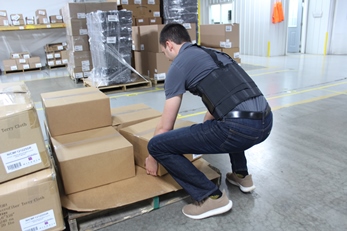Back Belts: Another Approach to Address the Challenge of Back Injuries
According to a report released in November 2016 by the Bureau of Labor Statistics, the overall incidence of nonfatal work-related injuries and illness cases that required days away from work to recuperate was 104.0 cases per 10,000 full-time workers.
Although many of these injuries included such things as bruises, cuts, and lacerations to the skin while working, the most significant percentage of occupational injuries and illnesses were what were termed "sprains, strains, and tears." This was followed by "soreness and pain." The bulk of these types of injuries are back-related.
The BLS report also noted that "occupations that had among the highest number of cases in 2015 resulting in days away from work included heavy and tractor-trailer truck drivers; laborers and freight, stock, and material movers." These are precisely the types of workers we find in distribution centers throughout the United States, as well as in manufacturing facilities. In most cases, workers did not return to work for seven to eight days after their injuries occurred; in about 20 percent of the cases, workers were off work for as long as one month. Further, the report shows that "private sector laborers and freight, stock, and material movers had 56,550 days-away-from-work cases in 2015, an increase from 2014 levels."
So far, we have been describing the human costs of occupational injuries. As we know, there are many direct and indirect costs to businesses, as well. Back injuries account for nearly 20 percent of all injuries and illnesses in the workplace and cost the nation an estimated $20 billion to $50 billion annually, according to the Centers for Disease Control and Prevention.
Digging deeper into the issues surrounding back injuries, we find that a large percentage of occupational back injuries are caused by manual lifting of boxes and products on the distribution or manufacturing floor. To address this problem, the National Institute for Occupational Safety and Health (NIOSH) has suggested the implementation of ergonomic programs, teaching workers best practices when lifting and moving items to help prevent back injuries, as well as suggesting to employers ways of redesigning the work environment to help reduce these injuries.

In addition to training workers improved ways to move, the use of industrial back belts is another approach to help address the challenge of back injuries. Since about the mid-1990s, the wearing of industrial back belts has seen a dramatic increase in the United States. However, in many ways, calling them back belts or back supports is a misnomer. A better and more accurate term would be "abdominal" belts. According to one study, back belts work by doing the following:
"By assisting the abdominal muscles and diaphragm in producing intra-abdominal pressure (IAP) within the abdominal cavity. This is thought to allow pressure on the upper body to be shifted from the spine to the trunk."1
In other words, the back belt redirects the pressure and strain of lifting from the lower back to the trunk, helping to protect the back and prevent injury. Further, back belts are thought to help improve posture, so that workers lift items more correctly, using an upright or straight torso. This also puts less stress on the back when lifting.
Further, research has found wearing a back belt can benefit workers in ways they may not even realize. For instance:
- They serve as a reminder to workers to be careful, lift properly, and not strain the body.
- They can increase insulation and warmth; the body tends to be more flexible in such conditions.
- They help restrict movements, bending, and twisting that can result in injuries.
- They provide what is termed "circumferential support" for the entire body. In other words, the worker feels more stable and more protected overall.
Proper Wearing of Back Belts
The wearing of back belts or back supports is not a cure-all. They help support the back and can offer some protection, but ultimately the worker must perform the lifting and moving of materials properly.
In order to provide this support most effectively, they must be selected and worn properly. The following are some suggestions to help accomplish this:
- Select the proper size; some belts have as many as four stays for added support.
- The belt's back panel should be 7 to 8 inches wide.
- If the belt has suspenders, make sure they are comfortably placed over the head, neck, and shoulders.
- Center the belt on the lower back and grasp each end of the belt.
- Stretch the belt straight out and wrap around the body; secure using the Velcro closure material.
It's interesting. We always see weight lifters wearing belts to provide additional back support. They do so because they know that the belt can help give them greater stability, put less strain on the back, and help them lift properly. This is exactly how back belts are designed to function in the workplace.
Dennis Knapp is Director of Product Development for Impact Products, LLC. Impact Products is a manufacturer of industrial health and safety products. He can be reached through his company website at https://www.impact-products.com.
Reference
1. ErgoPlus, a leading organization that helps employers prevent musculoskeletal injuries. NOTE: Many injuries are never reported, which can cause the numbers to be skewed.
Posted on May 17, 2019